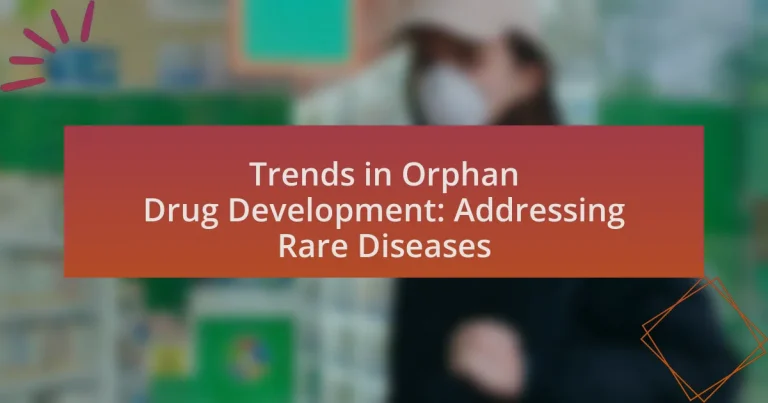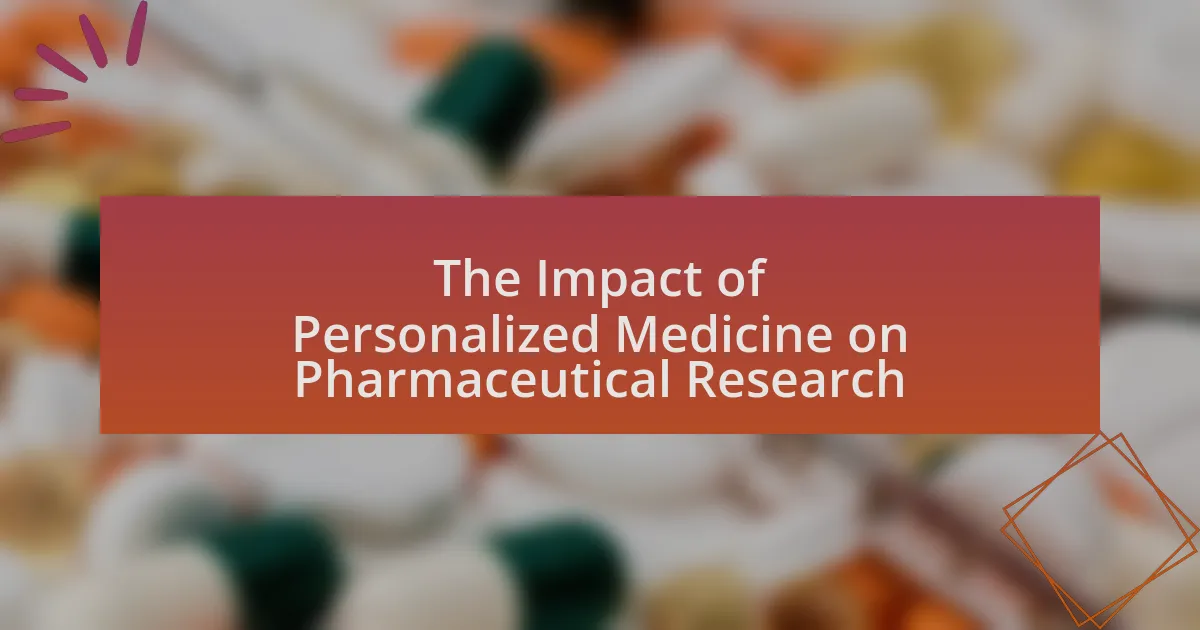The article focuses on current trends in orphan drug development, emphasizing increased investment, advancements in gene therapies, and the integration of artificial intelligence in drug discovery. It highlights the significant growth of the orphan drug market, projected to reach approximately $246 billion by 2026, driven by regulatory incentives and a patient-centric approach. The article also discusses the impact of regulatory changes, such as the Orphan Drug Modernization Plan, on the approval process, the role of patient advocacy in shaping research priorities, and the challenges faced in developing treatments for rare diseases, including funding constraints and recruitment difficulties. Additionally, it explores emerging therapeutic approaches and best practices for successful orphan drug development.
What are the current trends in orphan drug development?
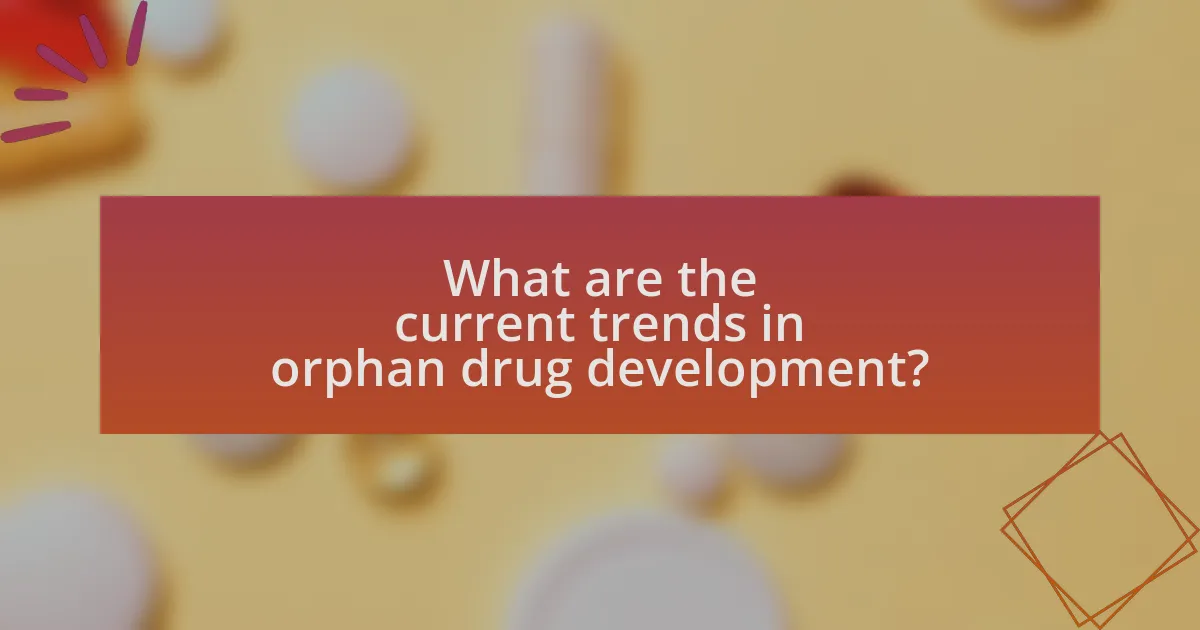
Current trends in orphan drug development include increased investment in research and development, a focus on gene therapies, and the use of artificial intelligence for drug discovery. The orphan drug market has seen a significant rise, with the global market expected to reach approximately $246 billion by 2026, driven by advancements in biotechnology and regulatory incentives. Additionally, regulatory agencies like the FDA and EMA are streamlining approval processes, which encourages pharmaceutical companies to pursue treatments for rare diseases. The growing emphasis on patient-centric approaches and real-world evidence is also shaping the landscape, ensuring that therapies are tailored to meet the specific needs of patients with rare conditions.
How are regulatory changes influencing orphan drug development?
Regulatory changes are significantly influencing orphan drug development by streamlining approval processes and providing incentives for pharmaceutical companies. For instance, the Orphan Drug Act in the United States offers tax credits, market exclusivity for seven years, and reduced fees for companies developing drugs for rare diseases, which encourages investment in this area. Additionally, recent modifications to regulations, such as the FDA’s 21st Century Cures Act, have further expedited the review process for orphan drugs, allowing for faster access to treatments for patients with rare conditions. These regulatory frameworks have led to a notable increase in the number of orphan drugs approved, with over 800 orphan designations granted by the FDA in 2020 alone, demonstrating the positive impact of these changes on drug development for rare diseases.
What specific regulations have been implemented recently?
Recently, the U.S. Food and Drug Administration (FDA) implemented the Orphan Drug Modernization Plan, which aims to streamline the approval process for orphan drugs targeting rare diseases. This plan includes measures such as enhancing communication between the FDA and drug developers, providing clearer guidance on clinical trial design, and expediting the review process for orphan drug applications. These changes are supported by the FDA’s commitment to address the unmet medical needs of patients with rare diseases, as evidenced by the increase in orphan drug designations, which reached over 600 in 2022 alone.
How do these regulations impact the approval process for orphan drugs?
Regulations significantly expedite the approval process for orphan drugs by providing incentives such as tax credits, grant funding, and a seven-year market exclusivity period. These incentives encourage pharmaceutical companies to invest in the development of treatments for rare diseases, which may otherwise be financially unviable due to limited patient populations. For instance, the Orphan Drug Act of 1983 in the United States has led to the approval of over 700 orphan drugs, demonstrating the effectiveness of these regulations in fostering innovation in rare disease treatment.
What role does patient advocacy play in orphan drug development?
Patient advocacy plays a crucial role in orphan drug development by representing the interests and needs of patients with rare diseases. Advocacy groups often provide essential insights into the patient experience, which can guide research priorities and influence drug development processes. For instance, they help identify unmet medical needs, facilitate communication between stakeholders, and promote awareness of specific conditions, thereby driving funding and regulatory support. Evidence shows that patient advocacy has led to increased collaboration between pharmaceutical companies and patient organizations, resulting in more targeted and effective treatments for rare diseases.
How do patient advocacy groups influence research priorities?
Patient advocacy groups influence research priorities by actively advocating for specific diseases and conditions, thereby shaping funding and research agendas. These groups often mobilize patients and families to raise awareness, which can lead to increased public and private investment in research. For example, the National Organization for Rare Disorders (NORD) has successfully lobbied for legislative changes that prioritize funding for rare disease research, demonstrating the tangible impact of advocacy efforts on research priorities. Additionally, patient advocacy groups frequently collaborate with researchers and pharmaceutical companies to identify unmet needs, ensuring that research aligns with patient interests and experiences.
What are the benefits of collaboration between patients and pharmaceutical companies?
Collaboration between patients and pharmaceutical companies enhances drug development and improves treatment outcomes. This partnership allows pharmaceutical companies to gain valuable insights into patient experiences, needs, and preferences, which can inform the design of clinical trials and the development of more effective therapies. For instance, involving patients in the drug development process can lead to more relevant endpoints and better patient adherence to treatment regimens. Additionally, such collaboration can foster trust and transparency, ultimately leading to increased patient engagement and participation in clinical trials. Research indicates that patient involvement can accelerate the development timeline and improve the likelihood of regulatory approval, as evidenced by the FDA’s emphasis on patient-centered outcomes in its guidance for drug development.
Why is there an increasing focus on rare diseases in drug development?
There is an increasing focus on rare diseases in drug development due to the growing recognition of unmet medical needs and advancements in biotechnology. The orphan drug market has expanded significantly, with over 1,000 orphan drugs approved by the FDA since the Orphan Drug Act was enacted in 1983, highlighting the potential for innovation and profitability in this area. Additionally, regulatory incentives, such as tax credits and market exclusivity, encourage pharmaceutical companies to invest in rare disease research, making it a more attractive field for drug development.
What factors contribute to the rise in rare disease prevalence?
The rise in rare disease prevalence is primarily attributed to improved diagnostic capabilities and increased awareness among healthcare professionals and the public. Enhanced genetic testing technologies have enabled the identification of previously unrecognized rare diseases, leading to more accurate diagnoses. Additionally, the expansion of medical research and patient advocacy has heightened awareness, resulting in more individuals seeking medical attention for rare conditions. According to the National Institutes of Health, approximately 7,000 rare diseases affect an estimated 30 million Americans, illustrating the significant impact of these factors on prevalence rates.
How does the market potential for orphan drugs compare to traditional drugs?
The market potential for orphan drugs is significantly higher than that for traditional drugs due to the unique regulatory incentives and the high unmet medical needs associated with rare diseases. Orphan drugs often receive expedited approval processes, tax credits, and extended market exclusivity, which can lead to higher prices and profitability. For instance, the average annual cost of orphan drugs can exceed $100,000, compared to traditional drugs, which typically range from $1,000 to $10,000 annually. Additionally, the orphan drug market is projected to grow at a compound annual growth rate (CAGR) of around 11% from 2021 to 2028, while the traditional drug market is expected to grow at a slower rate of approximately 5%. This disparity highlights the lucrative opportunities in orphan drug development, driven by both regulatory support and the critical need for treatments in underserved patient populations.
What challenges are faced in orphan drug development?
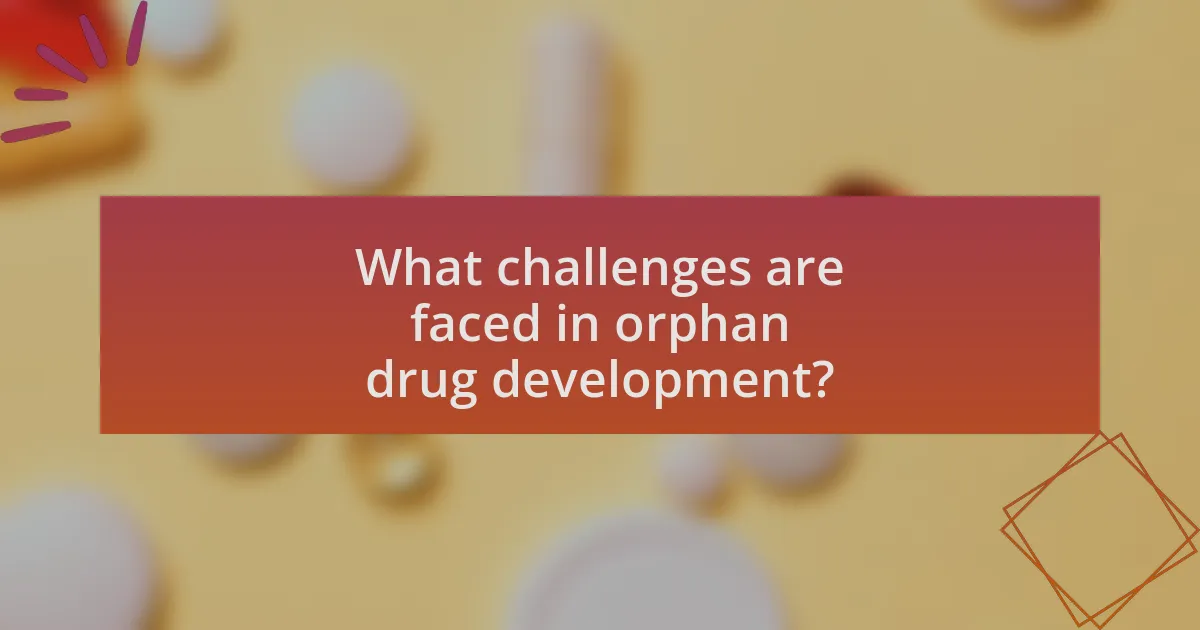
Orphan drug development faces significant challenges, including limited patient populations, high research and development costs, and regulatory hurdles. The small number of patients with rare diseases makes it difficult to conduct large-scale clinical trials, which can lead to insufficient data for regulatory approval. Additionally, the financial burden of developing these drugs can deter pharmaceutical companies, as the potential market may not justify the investment. Regulatory agencies often require extensive evidence of safety and efficacy, which can complicate the approval process for orphan drugs.
How do funding and financial constraints affect orphan drug research?
Funding and financial constraints significantly hinder orphan drug research by limiting the resources available for development and clinical trials. The high costs associated with research and development, often exceeding $1 billion for a single drug, create barriers for companies, especially smaller biotech firms that may lack sufficient capital. According to a study published in the journal “Nature Reviews Drug Discovery,” only about 10% of orphan drugs reach the market, largely due to financial limitations that restrict investment in necessary research phases. Furthermore, the limited patient populations for rare diseases result in lower potential returns on investment, discouraging pharmaceutical companies from pursuing these projects. This financial landscape leads to fewer innovative treatments being developed for patients with rare diseases.
What are the common sources of funding for orphan drug development?
Common sources of funding for orphan drug development include government grants, venture capital, pharmaceutical company investments, and nonprofit organizations. Government grants, such as those from the National Institutes of Health (NIH) and the Orphan Drug Act in the United States, provide financial support specifically for rare disease research. Venture capital firms often invest in biotech companies focused on orphan drugs due to the potential for high returns, given the market exclusivity granted by regulatory agencies. Additionally, pharmaceutical companies may allocate funds for orphan drug development as part of their research and development budgets, recognizing the growing market for rare diseases. Nonprofit organizations also play a crucial role by funding research initiatives and supporting clinical trials for orphan drugs, often driven by patient advocacy and the need for treatment options.
How do financial challenges impact the timeline for drug development?
Financial challenges significantly extend the timeline for drug development by limiting the resources available for research, clinical trials, and regulatory processes. Insufficient funding can lead to delays in critical phases such as preclinical testing and clinical trials, as companies may struggle to secure the necessary capital to advance their projects. For instance, a study published in the journal “Nature Reviews Drug Discovery” highlights that the average cost to develop a new drug exceeds $2.6 billion, and financial constraints can result in the postponement of trials or the abandonment of promising candidates altogether. This ultimately affects the speed at which new treatments for rare diseases are brought to market, as companies may prioritize projects with more immediate financial returns over those targeting less common conditions.
What scientific hurdles must be overcome in developing orphan drugs?
Developing orphan drugs faces several scientific hurdles, including limited understanding of rare diseases, challenges in identifying suitable biomarkers, and difficulties in conducting clinical trials due to small patient populations. The limited understanding of rare diseases often results in inadequate knowledge of disease mechanisms, which complicates drug target identification. Additionally, the scarcity of biomarkers makes it challenging to measure drug efficacy and safety accurately. Furthermore, small patient populations hinder the feasibility of large-scale clinical trials, leading to issues with statistical power and regulatory approval. These factors collectively impede the progress of orphan drug development.
What are the unique biological challenges associated with rare diseases?
Rare diseases present unique biological challenges primarily due to their genetic and phenotypic diversity. This diversity complicates diagnosis, as many rare diseases share overlapping symptoms, leading to misdiagnosis or delayed treatment. Additionally, the underlying genetic mutations often result in complex pathophysiological mechanisms that are not well understood, hindering the development of targeted therapies. For instance, the National Institutes of Health estimates that approximately 80% of rare diseases have a genetic basis, which can involve single-gene mutations, chromosomal abnormalities, or multifactorial inheritance patterns. This genetic variability necessitates personalized treatment approaches, which are difficult to standardize and implement in clinical practice. Furthermore, the limited patient populations for clinical trials restrict the statistical power needed to validate treatment efficacy and safety, making it challenging to bring effective therapies to market.
How do these challenges affect clinical trial design?
Challenges in orphan drug development significantly impact clinical trial design by necessitating innovative methodologies to accommodate small patient populations. Due to the rarity of the diseases, traditional trial designs may not be feasible, leading to the adoption of adaptive trial designs that allow for modifications based on interim results. Additionally, regulatory agencies often require more flexible endpoints and statistical approaches to ensure that the trials remain scientifically valid despite the limited data. For instance, the FDA’s Orphan Drug Act encourages the use of surrogate endpoints, which can expedite the approval process while still addressing the unique challenges posed by rare diseases.
Why is patient recruitment a significant issue in orphan drug trials?
Patient recruitment is a significant issue in orphan drug trials due to the limited number of patients available with rare diseases. The prevalence of these conditions often results in small patient populations, making it challenging to find enough eligible participants for clinical studies. For instance, according to the National Organization for Rare Disorders, there are over 7,000 known rare diseases, affecting approximately 1 in 10 Americans, which complicates recruitment efforts as many of these diseases have very few diagnosed individuals. Additionally, the geographical dispersion of patients can hinder recruitment, as they may be located far from trial sites, further reducing participation rates.
What strategies can be employed to improve patient recruitment?
To improve patient recruitment for orphan drug development, targeted outreach strategies should be employed. These strategies include leveraging patient registries, collaborating with patient advocacy groups, and utilizing social media platforms to reach potential participants. For instance, studies have shown that engaging with patient advocacy organizations can enhance recruitment by 30% due to their established trust within the community. Additionally, employing digital tools for remote screening and telehealth consultations can facilitate access for patients in remote areas, thereby increasing participation rates.
How does the rarity of diseases complicate recruitment efforts?
The rarity of diseases complicates recruitment efforts by significantly limiting the pool of eligible participants for clinical trials. For instance, rare diseases affect fewer than 200,000 individuals in the United States, making it challenging to find enough patients who meet specific criteria for studies. This scarcity can lead to prolonged recruitment timelines and increased costs, as researchers may need to expand their search geographically or employ alternative recruitment strategies. Additionally, the lack of awareness about rare diseases among both the public and healthcare providers further hinders recruitment, as potential participants may not recognize their eligibility or the importance of participating in research.
What are the future directions for orphan drug development?
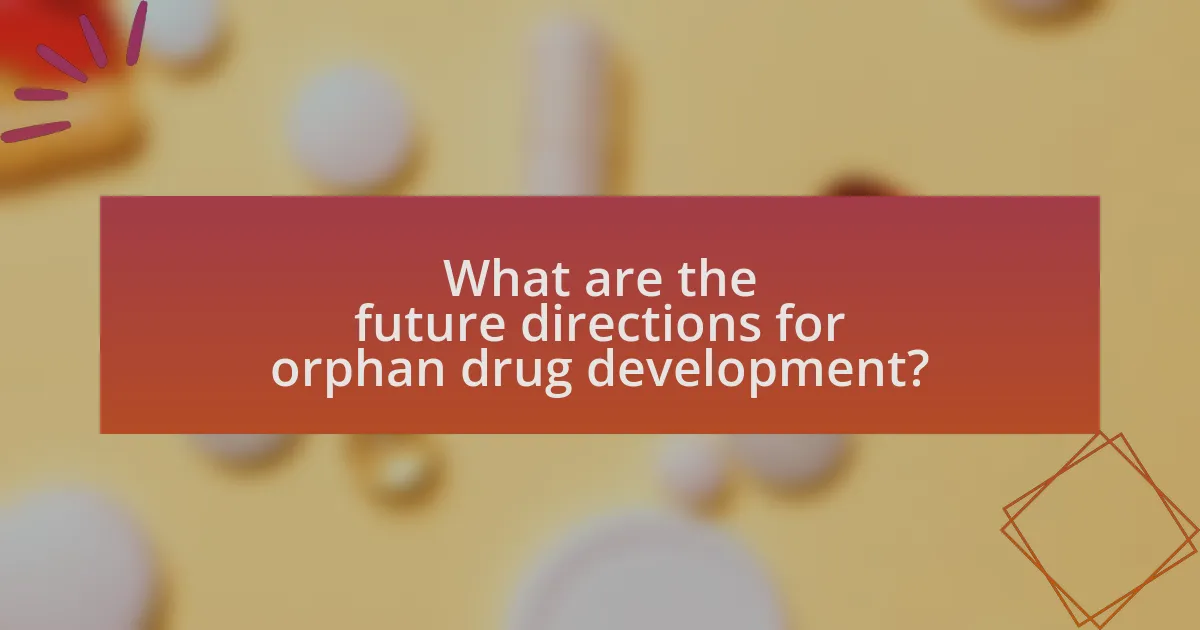
Future directions for orphan drug development include increased collaboration between pharmaceutical companies, regulatory agencies, and patient advocacy groups to streamline the approval process. This collaboration aims to enhance the efficiency of clinical trials and expand access to therapies for rare diseases. Additionally, advancements in genomic medicine and personalized therapies are expected to play a significant role, as they allow for targeted treatments that address the specific genetic mutations associated with rare conditions. The growing use of real-world evidence and data analytics will also support the development of orphan drugs by providing insights into patient outcomes and treatment effectiveness. These trends are supported by the increasing number of orphan drugs approved, which reached over 400 in the last decade, highlighting the evolving landscape of rare disease treatment.
How is technology shaping the future of orphan drug development?
Technology is significantly shaping the future of orphan drug development by enhancing research efficiency, improving patient recruitment, and facilitating personalized medicine. Advanced data analytics and artificial intelligence enable researchers to identify potential drug candidates more quickly and accurately, streamlining the drug discovery process. For instance, the use of machine learning algorithms can analyze vast datasets to uncover genetic markers associated with rare diseases, leading to targeted therapies. Additionally, digital platforms and social media are improving patient recruitment for clinical trials, allowing for faster enrollment of participants with specific rare conditions. This is crucial, as orphan drugs often face challenges in finding sufficient patient populations for studies. Furthermore, technology supports the development of personalized medicine approaches, tailoring treatments to individual genetic profiles, which is particularly beneficial in addressing the unique needs of patients with rare diseases.
What role do advancements in genomics play in identifying rare diseases?
Advancements in genomics significantly enhance the identification of rare diseases by enabling precise genetic analysis and the discovery of disease-causing mutations. These technological improvements, such as next-generation sequencing, allow for the rapid sequencing of entire genomes, which can reveal genetic variations linked to specific rare conditions. For instance, studies have shown that genomic sequencing can identify pathogenic variants in approximately 25% of patients with undiagnosed rare diseases, facilitating accurate diagnosis and targeted treatment options. This capability not only accelerates the diagnostic process but also informs the development of orphan drugs tailored to the genetic profiles of these diseases.
How can artificial intelligence enhance drug discovery for rare diseases?
Artificial intelligence can enhance drug discovery for rare diseases by accelerating the identification of potential drug candidates and optimizing clinical trial designs. AI algorithms analyze vast datasets, including genetic information and clinical records, to uncover patterns and predict how different compounds may interact with specific disease pathways. For instance, a study published in Nature Biotechnology demonstrated that AI models could predict the efficacy of drug candidates with over 90% accuracy, significantly reducing the time and cost associated with traditional drug discovery methods. This capability is particularly crucial for rare diseases, where patient populations are small, and traditional research approaches may be inefficient.
What are the emerging therapeutic approaches in orphan drug development?
Emerging therapeutic approaches in orphan drug development include gene therapy, cell therapy, and targeted therapies. Gene therapy aims to correct or replace defective genes responsible for rare diseases, exemplified by treatments like Luxturna for inherited retinal disease. Cell therapy involves using stem cells or modified immune cells to treat conditions such as spinal muscular atrophy, with Zolgensma being a notable example. Targeted therapies focus on specific molecular targets associated with rare diseases, as seen in the use of small molecules or monoclonal antibodies for conditions like cystic fibrosis. These approaches are gaining traction due to advancements in biotechnology and regulatory incentives that encourage innovation in treating rare diseases.
How do gene therapies and personalized medicine fit into orphan drug strategies?
Gene therapies and personalized medicine are integral to orphan drug strategies as they provide targeted treatments for rare diseases that often lack effective therapies. These approaches leverage genetic insights and individual patient data to develop tailored interventions, addressing the unique molecular mechanisms underlying specific orphan conditions. For instance, the FDA has approved several gene therapies, such as Zolgensma for spinal muscular atrophy, which exemplifies how innovative treatments can directly impact rare disease management. Personalized medicine enhances the efficacy of orphan drugs by ensuring that therapies are matched to the genetic profiles of patients, thereby improving outcomes and minimizing adverse effects.
What potential do biologics hold for treating rare diseases?
Biologics hold significant potential for treating rare diseases due to their ability to target specific biological pathways and mechanisms. These therapies, which include monoclonal antibodies, recombinant proteins, and gene therapies, can address the underlying causes of rare diseases rather than just alleviating symptoms. For instance, the approval of biologics like Eculizumab for treating atypical hemolytic uremic syndrome demonstrates their effectiveness in managing conditions that lack adequate treatment options. Additionally, the growing number of biologics in clinical trials reflects an increasing recognition of their role in orphan drug development, with over 300 biologics currently under investigation for various rare diseases. This trend underscores the transformative impact biologics can have in improving patient outcomes and advancing the field of rare disease treatment.
What best practices can be adopted for successful orphan drug development?
Successful orphan drug development can be achieved by adopting best practices such as early and continuous engagement with regulatory authorities, conducting robust clinical trials tailored to small patient populations, and leveraging innovative trial designs like adaptive trials. Early engagement with regulatory bodies, such as the FDA or EMA, ensures alignment on development plans and facilitates access to guidance on regulatory requirements specific to orphan drugs. Tailored clinical trials are essential due to the limited number of patients, which necessitates careful selection of endpoints and inclusion criteria to ensure meaningful results. Innovative trial designs, including adaptive trials, allow for modifications based on interim results, optimizing resource use and potentially accelerating the development timeline. These practices are supported by data indicating that early regulatory interactions can significantly reduce time to market and improve the likelihood of successful approval.
How can collaboration between stakeholders improve outcomes in orphan drug development?
Collaboration between stakeholders can significantly improve outcomes in orphan drug development by fostering shared resources, expertise, and data, which accelerates the research and approval process. When pharmaceutical companies, academic institutions, patient advocacy groups, and regulatory bodies work together, they can streamline clinical trials, enhance patient recruitment, and ensure that the needs of patients are prioritized. For instance, the FDA’s Orphan Drug Designation program encourages collaboration by providing incentives for companies that partner with patient organizations, leading to more effective drug development strategies. This collaborative approach has been shown to reduce the time to market for orphan drugs, as evidenced by the increase in orphan drug approvals from 2000 to 2020, where the number rose from 10 to over 200 annually, highlighting the positive impact of stakeholder collaboration on addressing rare diseases.
What lessons can be learned from successful orphan drug case studies?
Successful orphan drug case studies reveal several key lessons, including the importance of early engagement with regulatory agencies, the value of patient advocacy, and the necessity of innovative funding strategies. Early engagement with regulatory bodies, such as the FDA or EMA, facilitates a clearer understanding of the requirements for approval, as seen in the development of drugs like Spinraza for spinal muscular atrophy, which benefited from the FDA’s Orphan Drug Designation. Patient advocacy plays a crucial role in raising awareness and driving research, exemplified by the efforts of organizations like the Cystic Fibrosis Foundation, which helped accelerate the development of therapies for cystic fibrosis. Additionally, innovative funding strategies, such as public-private partnerships and venture philanthropy, have proven effective in supporting orphan drug development, as demonstrated by the success of the drug Kalydeco for cystic fibrosis, which was developed through collaboration between Vertex Pharmaceuticals and the Cystic Fibrosis Foundation. These lessons underscore the multifaceted approach required to successfully navigate the challenges of orphan drug development.
